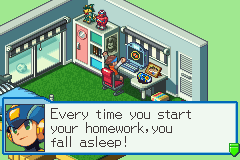
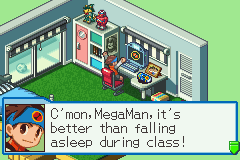
Gameplay
Banking on the success of real life card games like Magic: The Gathering, the makers of Megaman (Capcom) decides to incorporate these ideas to bring new gameplay styles to this renowned game character. Players are able to collect items in-game (in this game, they are termed as "chips")
Megaman Battle Network 5 is the fifth installation of the series where the new style of game has been introduced. With the release of each installation, more ideas and functions are added to the interface from previous releases. This gives the series a sense of continuity without the feel of boredom.
User Interface:
The game uses 3 basic user interfaces that takes the players through various stages of the game. Basic controls are carried out using a direction pad and 4 buttons available on the handheld console.


The "world" interface is where the player takes control of the character and interacts with its environment. Dialogues and actions are available in this interface to allow the player to progress through the stories of the game.
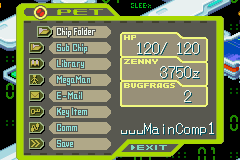
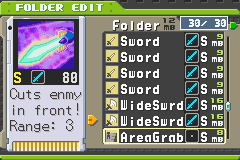
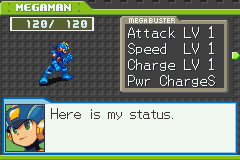
The "menu" interface allows the player to manage the character and his inventory. This allows the player to gear his character to his playing style. The menu also provides an "E-mail" which is actually a quest log which keep tracks of your progress and reminds you of your objectives. Gameboy Advance allows players to link up their handheld consoles for interaction. In the case of this game, the communication between 2 players can be in the form of battling or trading. They can engage in duels with their customised characters or they can exchange items they acquire in the game to make their characters stronger.
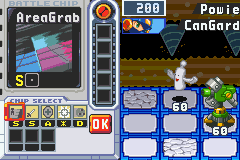
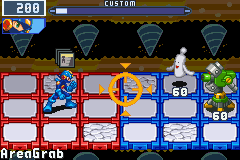
The "battle" interface is where the player combats various enemies that he encounters in-game. The fights occurs on a grid map where the player can do actions in real time. Over some elapsed time, players are able to pause the game and go into a menu that allows them to choose the items they can use. For a more detailed display of the battle scenes, refer to the Videos section.
Review:
On the one hand, Megaman Battle Network 5 improves on the features that were introduced in the previous games and implements some new features that longtime fans should appreciate. On the other hand, it also retains the same graphics, audio, and basic game design that have been with the series since its inception roughly four years ago.
Capcom hasn't changed the way combat works. Battles still take place on a 6-by-3 grid that's split evenly into player and enemy areas. Instead of taking turns, like you would in a traditional role-playing game, you and your enemies can move and attack in real time. Apart from his buster cannon, the majority of Megaman's attacks are contained on tiny cards known as battle chips. Five chips are randomly selected at the beginning of each battle, and when they're used, others are drawn to take their places. Some chips are better against certain types of enemies, and some can dole out damage to a whole swath of grid squares. Multiple attacks can be chained together by using chips with the same name or letter designation, and some chips can be combined to create stronger attacks by linking together three chips with the same name and sequential letter designations. You can only bring 30 chips into battle with you, so that's where most of the game's strategy comes from: collecting, organizing, and storing useful battle chips in your active folder. In all, there are 287 unique chips to find and collect.
The main thing this fifth game does differently from its predecessors is give players the ability to alternate between multiple Navis (in addition to Megaman) during so-called liberation missions. Liberation missions are basically just turn-based variations of cyberspace levels. Each level is filled with dark panels that block your way to the boss. By using the Navis on your team, your goal is to liberate dark panels until you clear a path. Each dark panel contains a group of viruses--so battles aren't random--but you can only liberate one panel per turn with each Navi. Once all your Navis have been used, your turn ends, and the boss gets its chance to heal its minions or conjure new viruses to stand in your way. By the end of the game, you'll be controlling as many as six other Navis during liberation mission levels. They don't have chip folders of their own (instead, everyone uses Megaman's active folder), which is sort of lame, but each Navi does at least have its own special attack chip and unique buster cannon attack. Some Navis also have the ability to hop over certain panels in a level or to dish out damage without actually starting up the battle interface.
Megaman Battle Network 5 is available in two different versions: Team Colonel and Team Protoman. The story and locations in both versions are the same, but you encounter different bosses and enlist different Navis to your team depending on which version you play. Each version also offers a different set of soul unisons based on the Navis that join you. Soul unisons let you upgrade Megaman's buster cannon with other Navis' powers. For instance, uniting with Protoman transforms the buster cannon into a powerful sword. Neither version's soul unisons are particularly better than the other's, but, generally speaking, the unisons in Team Colonel focus on attacking multiple opponents, whereas the unisons in Team Protoman are geared toward maximizing the damage done to a single opponent.
Story | Now and Then| Gameplay | Videos